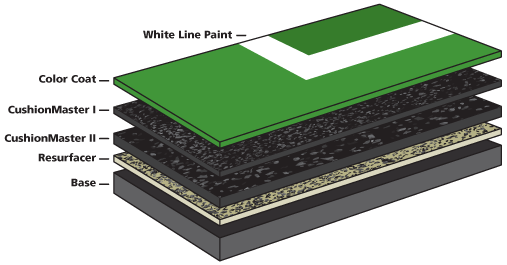Building a Pickleball Court Construction-- Expert Construction for Top Quality Play
Building a Pickleball Court Construction-- Expert Construction for Top Quality Play
Blog Article
Lasting Practices in Pickleball Court Building You Should Know
As the popularity of pickleball continues to climb, so as well does the demand for lasting techniques in court construction. The influence of these techniques prolongs far beyond the court itself.
Selecting Eco-Friendly Materials
Selecting environmentally friendly products is a vital action in the building and construction of lasting pickleball courts. The selection of sustainable products not only reduces ecological influence however likewise enhances the durability and performance of the court. Trick materials consist of reused rubber for the surface area, which uses exceptional resilience and shock absorption while diverting waste from land fills.
Furthermore, making use of locally sourced materials lowers transportation discharges and sustains regional economic climates. Pickleball court construction. As an example, utilizing native woods for fence and seats can supply a sustainable aesthetic while making certain strength versus the elements.
Integrating permeable products for court foundations can even more add to sustainability by permitting for all-natural water drainage and lowering overflow. These choices not just safeguard local environments however also advertise healthier play environments.
Reliable Drain Solutions
While the selection of environmentally friendly materials is crucial, applying effective drainage options is equally critical for keeping lasting pickleball courts. Proper water drainage not just safeguards the court surface from water damage yet additionally minimizes disintegration and drainage, advertising environmental honesty.
Effective drainage systems can consist of permeable paving, which allows water to infiltrate the ground as opposed to pooling externally. This lowers the probability of standing water, which can bring about mold and mildew and various other upkeep concerns. In addition, incorporating tactically put drain networks and swales can guide excess water away from the court area, making sure a completely dry having fun surface area and protecting against soil erosion.
Utilizing native vegetation in the landscaping around the courts can even more enhance drain by soaking up excess water and reducing runoff. These plants require much less irrigation and advertise biodiversity, straightening with lasting methods.
Additionally, it is critical to on a regular basis keep the drain system to guarantee its long-lasting efficiency. This consists of clearing up debris and monitoring for obstructions. By focusing on effective drainage services, pickleball court constructors can dramatically add to the sustainability and durability of the facility, inevitably benefiting both gamers and the setting.
Energy-Efficient Illumination Options
As the demand for pickleball remains to grow, incorporating energy-efficient lighting choices right into court layout has come to be increasingly vital for sustainability. Standard illumination systems commonly consume extreme power, contributing to greater operational prices and ecological influence. As a result, adopting modern-day, energy-efficient modern technologies is important for both new constructions and renovations.
LED (Light Emitting Diode) lighting stands out as a top choice due to its durability and power savings (Pickleball court construction). Contrasted to traditional lights, LEDs use roughly 75% less power and can last up to 25 times much longer, dramatically lowering maintenance costs. Furthermore, the directional nature of LED illumination reduces light pollution, ensuring that lighting is focused on the court rather than surrounding areas.

Lasting Surface Area Alternatives
Discovering lasting surface area alternatives for pickleball courts has actually acquired grip among gamers and builders alike. The emphasis on eco-friendly products not only aligns with the growing ecological understanding but additionally enhances the efficiency and toughness of the courts.
This product supplies outstanding shock absorption, reducing the threat of injuries for players while advertising sustainability. These floor tiles are simple to install and change, and their versatility permits for different court configurations.
Natural grass courts are also becoming a sustainable option, promoting biodiversity and minimizing the heat island impact. They need normal maintenance and water, which might not straighten with all sustainability objectives.

Water Preservation Techniques

One more effective strategy includes the installment of rainwater harvesting systems. These systems store and accumulate rainwater for Web Site usage in preserving court surfaces and landscape design. This technique not only preserves potable water yet likewise lowers reliance on metropolitan resources.
Furthermore, using drought-resistant landscaping around the courts is essential. Native plants call for less water and are better adjusted to regional environment problems, thus reducing total water consumption. In addition, making use of efficient irrigation systems, such as drip irrigation, makes sure that water is supplied straight to plant roots, reducing dissipation and waste.
Verdict
Integrating sustainable techniques in pickleball court building significantly adds to ecological preservation and resource efficiency. By focusing on these techniques, the building of pickleball courts can straighten with broader environmental objectives while advertising longevity and functionality within areas.
As the popularity of pickleball continues to increase, so also does the need for sustainable methods in court building and construction.Choosing environment-friendly materials is an essential anchor step in the building of lasting pickleball courts. By focusing on energy-efficient lights alternatives, pickleball court contractors can contribute to a much more sustainable future while meeting the needs of players and stakeholders alike.Incorporating lasting surface area choices not just boosts the efficiency of pickleball courts yet additionally leads the means for applying reliable water preservation methods.Incorporating lasting techniques in pickleball court building and construction dramatically adds to environmental preservation and source effectiveness.
Report this page